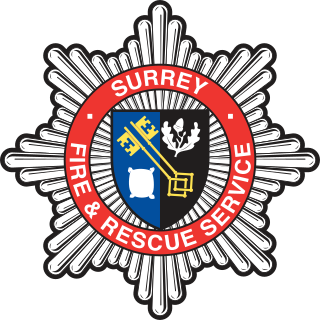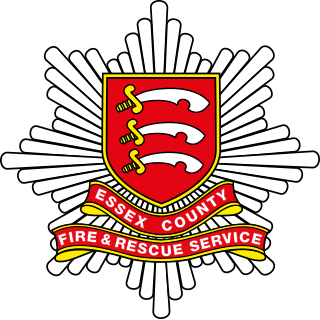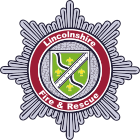
The Surrey Fire and Rescue Service is the statutory fire and rescue service for the County of Surrey, England, with 25 fire stations. It comes under the administrative and legislative control of Surrey County Council, acting as the Fire Authority who fund the service by collecting a precept via council tax, and from central government funds, known as a grant settlement, and provide the political leadership for the service.

The West Sussex Fire and Rescue Service is the statutory fire and rescue service for the administrative county of West Sussex, England. It is part of West Sussex County Council. As of March 2018, the county has 25 fire stations.
Bedfordshire Fire and Rescue Service is the fire and rescue service for the ceremonial county of Bedfordshire in England, consisting of the unitary authorities of Bedford, Central Bedfordshire, and Luton.

Devon and Somerset Fire and Rescue Service (DSFRS) is the statutory fire and rescue service covering the county of Devon and the unitary authorities of Plymouth, Torbay) and Somerset in South West England – an area of 3,924 square miles (10,160 km2). It serves a population of 1.75 million, and is the fifth largest fire and rescue service in the United Kingdom.
Cheshire Fire and Rescue Service is the statutory fire and rescue service for the English county of Cheshire, consisting of the unitary authorities of Cheshire East, Cheshire West and Chester, Halton and Warrington. It operates 28 fire stations. The service is led by Chief Fire Officer Alex Waller, who was appointed in 2022, and the Service Management Team. It is managed by the Cheshire Fire Authority, which is composed of councillors from the local communities of Cheshire, Halton and Warrington. They make decisions on issues such as policy, finance and resources.

Essex County Fire and Rescue Service (ECFRS) is the statutory fire and rescue service for the county of Essex in the east of England, and is one of the largest fire services in the country, covering an area of 1,338 square miles (3,470 km2) and a population of over 1.7 million people.
The Gloucestershire Fire and Rescue Service is the statutory emergency fire and rescue service for the non-metropolitan county of Gloucestershire, England. The service is run by Gloucestershire County Council. The service does not cover the unitary authority of South Gloucestershire which is covered by Avon Fire and Rescue Service.

East Sussex Fire & Rescue Service (ESFRS) is the statutory fire and rescue service for the county of East Sussex and city of Brighton and Hove, England. It is headquartered in Lewes. The service has a total of 24 fire stations.

Kent Fire and Rescue Service is the statutory fire and rescue service for the administrative county of Kent and the unitary authority area of Medway, covering a geographical area south of London, to the coast and including major shipping routes via the Thames and Medway rivers. The total coastline covered is 225 km ; it has 55 fire stations, and four district fire safety offices. The FRS provides emergency cover to a population of nearly 2 million.

The Hereford and Worcester Fire and Rescue Service (HWFRS) is the statutory fire and rescue service covering Herefordshire and Worcestershire in the West Midlands region of England. The service covers an area of 1,514 square miles (3,920 km2), and a population of around 780,000 people.

Warwickshire Fire and Rescue Service is the statutory fire and rescue service serving the county of Warwickshire in the West Midlands region of England.

Humberside Fire and Rescue Service (HFRS) is the statutory fire and rescue service covering the area of what was the county of Humberside (1974–1996), but now consists of the unitary authorities of East Riding of Yorkshire, Kingston upon Hull, North Lincolnshire and North East Lincolnshire in northern England.

Cleveland Fire Brigade is the statutory fire and rescue service covering the boroughs of Hartlepool, Middlesbrough, Redcar and Cleveland & Stockton-on-Tees in the North East of England. The name originates from the former county of Cleveland which was abolished in 1996. The brigade’s area is split between the ceremonial counties of County Durham and North Yorkshire.
Leicestershire Fire and Rescue Service is the fire and rescue service which serves the ceremonial counties of Leicestershire and Rutland in England. The service's headquarters are in Birstall, on the outskirts of Leicester.

Buckinghamshire Fire and Rescue Service, is the Local Authority Fire Service serving the English unitary authorities of Buckinghamshire and the City of Milton Keynes.

Hertfordshire Fire and Rescue Service (HFRS) is the statutory fire and rescue service for the county of Hertfordshire, England. HFRS covers an area of 1,514 square miles (3,920 km2) and a population of 1.19 million.

Cornwall Fire and Rescue Service is the statutory fire and rescue service covering Cornwall, England. As of April 2019, the service employs over 400 retained firefighters, 203 full-time firefighters, plus 170 support and administrative staff. Created under the Fire Services Act 1947 as "Cornwall Fire Brigade", the name changed to "Cornwall Fire and Rescue Service" on 1 October 2009.

Norfolk Fire and Rescue Service (NFRS) is the statutory fire and rescue service for the county of Norfolk in the east of England. The county consists of around 870,100 people, covering the 4th largest area in England with 2,074 square miles including 200 miles of inland waterways, 90 miles of coastline and 6,125 miles of roads. The county city is Norwich with other major towns including Great Yarmouth, King's Lynn and Thetford. Norfolk has one of the 20 Urban Search and Rescue teams across England and Wales which were set up in response to the 9/11 attacks. The teams, including Norfolk, have the capacity to deal with two simultaneous incidents across the UK.
Staffordshire Fire and Rescue Service is the statutory fire and rescue service responsible for fire protection, prevention, intervention and emergency rescue in the county of Staffordshire and unitary authority of Stoke-on-Trent. The county has a population of 1,126,200 and covers a total area of 2,260 km2. Staffordshire shares the majority of its border with Derbyshire, Cheshire, West Midlands (County) and Shropshire; although, in much shorter stretches, the county also butts up against Worcestershire, Warwickshire and Leicestershire.

Suffolk Fire and Rescue Service (SFRS) is the statutory fire and rescue service covering the county of Suffolk in East Anglia, England. It was formed in 1948 as the Suffolk & Ipswich Fire Service, before changing after the 1974 Local Government Review to 'Suffolk Fire Service'. Following the 2004 Fire & Rescue Services Act, the service name was changed to Suffolk Fire & Rescue Service to better reflect its role. Suffolk has a population of 760,556 and covers 1,466 square miles (3,800 km2). The county town is Ipswich with other major towns including Lowestoft, Bury St-Edmunds, Felixstowe and Newmarket.















